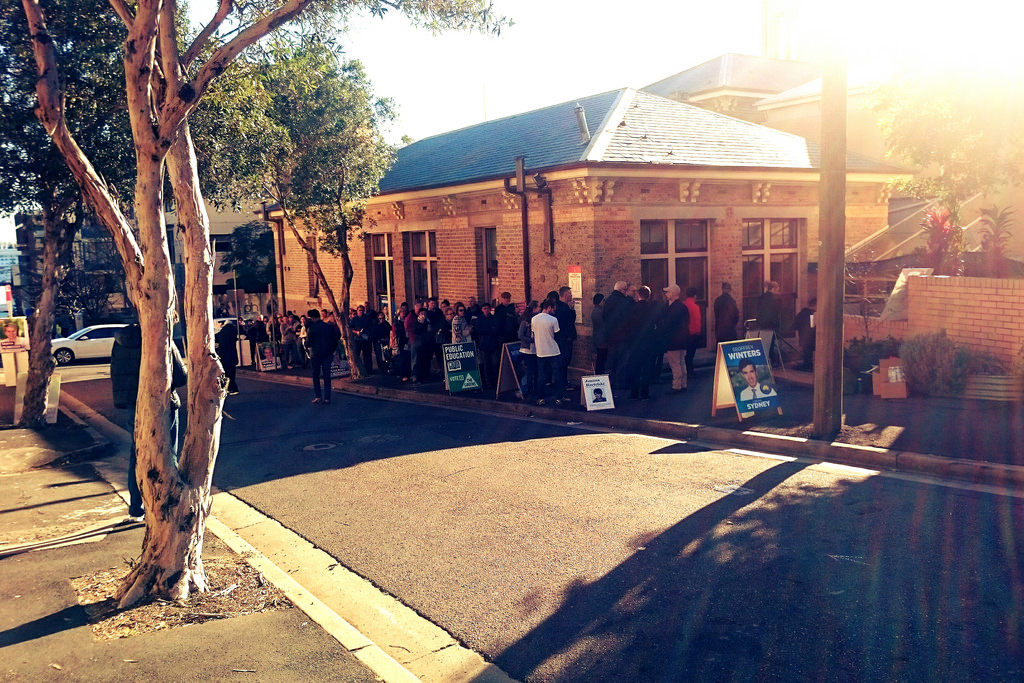Australia’s Unsatisfying Political Landscape Won’t Be Fixed by E-Voting
by Robbie Fordyce
15 July 2016

Australia has somehow just passed through an election with the political status quo looking largely intact, but neither side is particularly happy with the outcome so everyone’s gone all ‘electronic voting’.
From an outsider’s perspective, Australia is a country whose leader is often someone who wants, or expects, the job of governance to be easy. These people clearly think highly of themselves, perhaps rightly, but often seem to think they’re going to be the most intelligent or most popular person in Australia.
Now imagine a government full of these individuals, clawing, sniping, hacking away at each other, tearing off small shreds of self-respect, dignity, hope and policy, leaving skeletonised political carcasses with little strips of ideology hanging from the bones. The drama of the Tory leadership crisis in Britain – which led to the Brexit referendum, a leave vote and a subsequent collapse of the pound – appears largely routine in the Antipodes. The only difference is, there’s less at stake.
In any case, it’s been all of eight months since Australia’s last leadership crisis. Having just had another round of election with no notable campaigning moments whatsoever, it seems Australia is extremely close to a mythological stable government. We have the Australian Labor party, which is a somewhat chaotic combination of identities and agendas, including a number of individuals who appear to have infiltrated the party from the right. Labor ran a strong campaign, receiving 35% of the primary vote and approximately 45% of the seats in parliament. Then we have the ‘Coalition’, which is a long-standing alliance between the Liberal party and the National party. The Liberal party is a pro-privatisation, socially-liberal-when-politically-expedient, market-oriented party that is liberal only in the loosest of senses; the National party being a conservative, rural-focused party that gets a high proportion of seats to votes due to Australia’s stunningly low rural population counts. The Coalition received some 42% of the vote, and received 51% of the seats in parliament.
Anyway, it looks like we’ve got a few take-aways from this ludicrous display:
- The Liberal-National coalition has just barely won a majority, and the two major parties received 77% of the vote but received 96% of the seats.
- The white supremacist fascist groups banded together with Channel 7 and reelected celebrity racist Pauline Hanson.
- It looks like we’re going to have a nationwide non-binding referendum on marriage equality. I hear such things are always good and fair, that the outcomes are always great for everyone, and they never exacerbate existing social tensions to the point of violence.
- The referendum is costed at $160m. It seems ridiculous, but given that Malcolm Turnbull dropped some $50bn on 12 French submarines (whyyyy) last year, it’s kind of a drop in the bucket.
- The close vote meant the process of determining an outcome took a lot longer than normal, so everyone thinks we should shift to electronic voting.
All the votes are always counted in the election, but in this instance, the votes were extremely close in many regions, meaning that voting had to be more careful. Leaders from both the major parties are suggesting a shift to electronic voting is necessary, the justification being that Australia shouldn’t have to go a week without a leader.
It’s worth pointing out that electronic voting is going to cause way more problems than it will solve, at least with Australia’s current sociotechnical situation. There’s already some mediocre critique from the progressive left, and some perhaps more readable points as well. Missing from this is the recognition that historically e-voting developers – such as the e-voting company formerly known as Diebold – have been as corrupt as hell, prompting significant settlement costs to the company in many jurisdictions and a name change to Premier Election Solutions. These companies influence the outcome of elections directly, through manipulating electronic voting records, and were implicated in George Bush’s electoral victories in 2000 and 2004 (see the 2006 documentary Hacking Democracy). Not to mention, they’ve been widely criticised by one of the most respected computer security experts on the planet.
So the first question is: who is going to develop, install, maintain and store the whole e-voting process? The second question is: how is any nationwide system contingent on an internet connection expected to work, what with the National Broadband Network being essentially a hot pile of rotting copper?
To add to this, in Australia voting is compulsory; theoretically Australia gets 100% turnout. People who don’t want to vote for anyone (and don’t want to be fined) have to attend the voting ballot, and personally destroy their vote, often by drawing a penis on it. The penis part is optional but traditional, and alternative forms of defacement are also okay. With electronic voting that goes out the window – it’ll be impossible to perform donkey votes. People might not think this is a bad thing, but without any capacity for no-confidence votes, it’s as important to be able to refuse to vote as it is to vote in the first place.
But really, what no one’s really talking about is that in a system which supposedly provides greater scope for the proportional representation of minority voices, we’ve got two major parties comfortably dominating the voting arena, and about one in five people being unrepresented in parliament. No new-fangled electronic toolkit is going to change the structure of voting itself, it’ll just change the medium of delivery to another unfamiliar interface.
*Australia uses a semi-effective voting method that attempts to provide greater representation to minor parties, but as evidenced by this election, hasn’t really done that this time. Voters rank candidates, and if their first preference doesn’t receive enough votes to win a seat, then the vote is transferred to a second party.
Photo: Christopher Yardin/Flickr